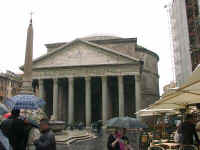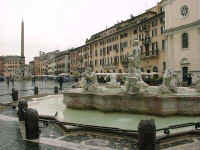|
Page 1 2 3 4 5 6 7 8 9 10 11 12 13 14 15 16 17 Rome Friday, 20 April. It was raining and we slept late since it was the first morning in Rome that we didn't have to be somewhere early. After breakfast at the corner bar, we caught the bus and subway to the Coliseum. It was only a short walk to the Domus Aurea. We explained what we'd been told about possible no-shows, but the ticket sellers acted like there was no such thing. We managed to walk a little way into the huge, vaulted entrance hall which provided a good idea of the scale of the palace. The Domus Aurea (Golden House) was one of Nero's most extravagant projects. After two-thirds of Rome was destroyed by fire in 64 A.D., Nero used this newly-available land as a site for his new palace. (Some say that he deliberately burned the city to clear the space.) The palace was really a series of buildings scattered over an artificially created "countryside," including an artificial lake. Most of it is now either gone or below ground level. Even after being closed 18 years for "renovations," relatively little remains of the once extravagant decorations. Nevertheless, it was a big disappointment not to see it. It was just reopened to the public in 1999. An interesting sidelight is the relationship between the Domus Aurea and the Colosseum. Nero had a 120-foot high bronze statue of himself (the Colossus Neronis) placed just outside of the entrance of his palace.. This monstrosity was built in imitation of the Colossus of Rhodes, one of the Seven Wonders of the Ancient World. Eventually Emperor Hadrian had the statue moved to the amphitheater built by Emperor Flavian in 72 A.D. By the Middle Ages, people were calling the amphitheater the "Colosseum" after the statue outside of it. The name stuck and is used to this day. Leaving the Domus Aurea, we took the bus a couple stops to the Forum. From there we walked up the Capitoline Hill (Campidoglio) to the Piazza Capitolina, surrounded on three sides by buildings designed by Michelangelo in 1567. Even in the rain it was a very impressive sight. There also was a great view of the Forum from just outside the Piazza. The buildings now house a museum, but we decided not to tour it. Instead, we walked down to Piazza Venezia, with the ornate Victor Emmanuel II monument (irreverently called the "wedding cake") on one side and Mussolini's famous balcony on another.
We followed s series of narrow streets to the Pantheon, stopping for a cappuccino along the way. There were more people in the Pantheon than we'd ever seen there before, including many children. But we were glad to see that the Piazza della Rotonda is now closed to traffic. Built about 120 A.D., this Roman temple had the world's largest dome (142 feet across) until the cathedral of Florence was built in 1436. It is in excellent condition, largely because it was converted to a Catholic church in 609. From the Pantheon we walked to the nearby Piazza Navona, designed by Bernini (17th century). It's a very long rectangle with a large fountain on each side and an obelisk on an elaborate pedestal in the center. The entire side opposite St. Agnes Church was lined with sidewalk cafes. While looking for a bus back to Termini, we stumbled across the Piazza Colona with its elaborately decorated bronze column (c. 180 A.D.) erected in honor of Marcus Aurelius. We eventually found a bus to Termini and had a late lunch in the station restaurant. The rain finally stopped while we were inside, but we decided we'd better go back to the hotel. We got there about 3:30 and started packing for tomorrow's departure. At 7:30 we went out for pizza, then called it a day. Page 1 2 3 4 5 6 7 8 9 10 11 12 13 14 15 16 17
Copyright © 2000-2023 DarrellPeck.com All rights
reserved. | |||









